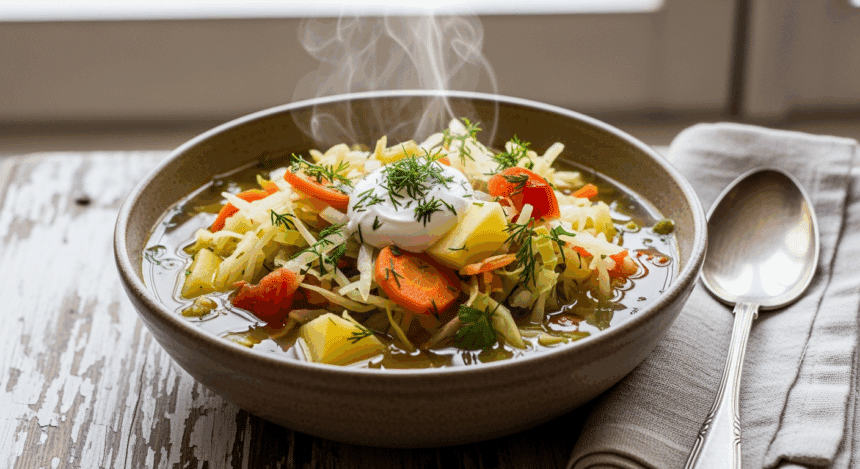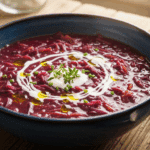Listen, I see you there, eyeing that head of cabbage in your fridge like it personally insulted your mother. Let’s turn that awkward vegetable standoff into something magical, shall we? This vegetarian cabbage soup is what happens when comfort food meets health food and they actually get along. Plus, it’s the perfect recipe for when you’re feeling lazy but still want to pretend you’ve got your life together.
Why This Recipe is Awesome
First off, this soup is basically a veggie party in a pot. It’s ridiculously nutritious while tasting like something you’d actually want to eat (miracle, I know). It’s also what I like to call “leftover-friendly” – toss in whatever sad vegetables are wilting in your crisper drawer, and suddenly they’re contributing members of soup society.
The best part? This recipe is completely idiot-proof. I once made it while simultaneously watching Netflix, texting my mom, and trying to keep my cat from walking across my keyboard. Still turned out great. If that’s not a culinary endorsement, I don’t know what is.
Ingredients You’ll Need
- 1 medium cabbage (you know, that round green thing you bought with good intentions)
- 2 carrots (the straighter they are, the less frustrating they are to chop)
- 1 large onion (tears are part of the flavor process, embrace them)
- 3 cloves garlic (or 5 if you’re not planning on kissing anyone)
- 2 potatoes (the lumpy ones with personality work just fine)
- 1 can diced tomatoes (the lazy cook’s best friend)
- 6 cups vegetable broth (homemade if you’re showing off, store-bought if you’re honest)
- 2 bay leaves (those weird leaves that you can never find at the store)
- 1 tsp each of dried thyme, oregano, and paprika (the holy trinity of “I look like I know what I’m doing”)
- Salt and pepper to taste (translation: keep adding until it tastes good)
- 2 tbsp olive oil (the good stuff, or whatever was on sale)
- Optional: 1 cup of white beans or chickpeas for protein (because someone will ask “but where’s the protein?”)
Step-by-Step Instructions
- Heat the olive oil in a large pot over medium heat. Chop your onion while practicing your not-crying techniques (spoiler: none of them work).
- Add the chopped onion to the pot and sauté until it’s translucent – that’s fancy chef-speak for “kinda see-through.” About 5 minutes should do it.
- Mince the garlic (or use a press if you value your fingertips) and toss it in. Stir for about 30 seconds until it’s fragrant. Don’t burn the garlic unless you want your kitchen to smell like disappointment.
- Chop your carrots and potatoes into bite-sized pieces. Add them to the pot and stir for 2-3 minutes. This is called “layering flavors,” which is just a fancy way of saying “cooking stuff in a specific order.”
- Core and roughly chop your cabbage. Don’t be precious about it – we’re making soup, not competing on a cooking show.
- Add the cabbage to the pot, stirring to coat with oil. It will look like way too much cabbage. Trust the process – like magic, it will shrink down and make you question the laws of physics.
- Pour in the vegetable broth and diced tomatoes. Add your herbs, bay leaves, salt, and pepper. Bring everything to a boil, then reduce to a simmer.
- Cover and let it simmer for about 25-30 minutes, or until the vegetables are tender. This is your free time to scroll through social media while feeling productive because “I’m cooking.”
- If using beans, add them in the last 5 minutes of cooking just to heat through.
- Taste and adjust seasonings. Always taste before serving – it’s the difference between “this is amazing” and “this needs… something.”
Common Mistakes to Avoid
Let’s talk about how not to mess this up, shall we?
- Overcooking the cabbage until it resembles swamp material. Nobody wants to eat translucent, mushy cabbage. Nobody.
- Under-seasoning because you’re afraid of salt. This isn’t a bland diet hospital food situation. Live a little.
- Cutting vegetables into wildly different sizes. Unless you enjoy having some pieces perfectly cooked while others remain basically raw, try for some consistency.
- Forgetting to remove the bay leaves before serving. They’re like nature’s prank – technically edible but definitely not enjoyable to bite into.
- Being stingy with the cooking time. Patience is a virtue, especially when it comes to letting flavors meld. This isn’t instant ramen, people.
Alternatives & Substitutions
Not everyone has a perfectly stocked pantry (or wants to eat exactly what I tell them to), so here are some swap options:
For the cabbage: You can use any type – green, red, savoy, napa. Red cabbage will turn your soup purple, which is either a fun surprise or a horrifying development, depending on your audience.
No fresh garlic? Use garlic powder in a pinch. It’s not the same, but it’s better than living a sad, garlic-free existence.
Vegetable broth alternatives: Water with bouillon cubes works fine. In desperate times, I’ve used water with extra herbs and a splash of soy sauce. No one ever knew. That’s between us, though.
Make it heartier: Add barley, rice, or small pasta shapes during the last 15-20 minutes of cooking (check package directions for timing). Just be warned that they’ll continue absorbing liquid during storage, potentially turning your leftover soup into a weird stew situation.
Spice it up: Add a dash of hot sauce, red pepper flakes, or a diced jalapeño if your taste buds aren’t cowards.
FAQ (Frequently Asked Questions)
How long will this soup keep in the fridge?
About 3-4 days. The flavors actually improve on day two, which is Mother Nature’s way of rewarding meal prep.
Can I freeze this soup?
Absolutely! Freeze in individual portions and you’ve basically created your own TV dinners, except they won’t make you sad when you eat them.
Is this soup good for weight loss?
I mean, it’s basically water and vegetables, so… yes? But I’m not a nutritionist, just someone who knows that eating a big bowl of vegetables probably isn’t going to make you gain weight. Unless you serve it with half a loaf of buttered bread. Which, TBH, I highly recommend.
My soup is too watery. What did I do wrong?
Nothing! But if you want a thicker soup, you can either: 1) puree a portion of it and add it back in, 2) add more vegetables, or 3) mix a tablespoon of cornstarch with cold water and stir it in. Or just call it “broth-forward” and pretend that’s what you were going for.
Can kids eat this?
Sure, if they’re the kind of kids who eat vegetables willingly. If not, try pureeing it completely and calling it “magic green soup” or whatever lie works on your particular children.
I don’t have [insert ingredient]. Can I still make this?
The only truly essential ingredient here is the cabbage. Everything else is negotiable. This soup is like the Switzerland of recipes – adaptable and unlikely to cause international incidents.
Final Thoughts
Look at you, making a vegetable-forward dish like some kind of functional adult! This soup is the culinary equivalent of a participation trophy – it’s almost impossible to mess up, and you still get to feel accomplished. Plus, it’s a great way to clean out your produce drawer while convincing yourself (and possibly others) that you planned it all along.
Serve this with some crusty bread, a sprinkle of fresh herbs if you’re feeling fancy, or just eat it straight from the pot while standing over your stove. I won’t judge – we’ve all been there. The beauty of cabbage soup is that it’s unpretentious comfort food that still counts as “eating healthy.” It’s basically having your cake and eating it too, except the cake is cabbage, and… okay, that analogy fell apart.
Now go forth and simmer with confidence! And remember – if anyone questions your culinary choices, just tell them you’re making “European peasant food” and watch them nod appreciatively.



